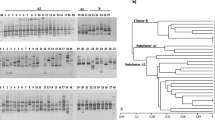Abstract
A rapid detection method based on PCR amplification of Pseudomonas syringae pv. tomato chromosomal sequences was developed. Primer design was based on the P. syringae DC3000 hrpZ Pst gene, which maps on a pathogenicity-associated operon of the hrp/hrc pathogenicity island.
A 532 bp product corresponding to an internal fragment of hrpZ Pst was amplified from 50 isolates of P. syringae pv. tomato belonging to a geographically representative collection. The amplification product was also obtained from three coronatine-deficient strains of P. syringae pv. tomato.On the other hand, PCR did not produce any such products from 100 pathogenic and symbiotic bacterial strains of the genera Pseudomonas, Xanthomonas, Erwinia, and Rhizobium and 75 unidentified bacterial saprophytes isolated from tomato plants. The method was tested using leaf and fruit spots from naturally-infected tomato plants and asymptomatic nursery plants and artificially contaminated tomato seeds. The results confirmed the high specificity observed using pure cultures.
Similar content being viewed by others
References
JR Alfano DW Bauer TM Milos A Collmer (1996) ArticleTitleAnalysis of the role of the Pseudomonas syringae pv. syringae HrpZ harpin in elicitation of the hypersensitive response in tobacco using functionally non-polar hrpZ deletion mutations, truncated HrpZ fragments, and hrmA mutations. Molecular Microbiology 19 715–728 Occurrence Handle1:CAS:528:DyaK28XhsVKhu7Y%3D Occurrence Handle8820642
JR Alfano A Collmer (1997) ArticleTitleThe type III (Hrp) secretion pathway of plant pathogenic bacteria: trafficking harpins, Avr proteins, and death Journal of Bacteriology 179 5655–5662 Occurrence Handle1:CAS:528:DyaK2sXmt1GgsLw%3D Occurrence Handle9294418
S Bereswill P Bugert B Volksch M Ullrich CL Bender K Geider (1994) ArticleTitleIdentification and relatedness of coronatine-producing Pseudomonas syringae pathovars by PCR analysis and sequence determination of the amplification products Applied and Environmental Microbiology 60 2924–2930 Occurrence Handle1:CAS:528:DyaK2cXlslWmtLw%3D Occurrence Handle7916181
A Braun-Kiewnick DC Sands (2001) Pseudomonas NW Schaad JB Jones W Chun (Eds) Laboratory Guide for Identification of Plant Pathogenic Bacteria APS Press, St. Paul MN, USA 84–120
DA Cuppels RA Moore VL Morris (1990) ArticleTitleConstruction and use of a nonradioactive DNA hybridization probe for detection of Pseudomonas syringae pv. tomato on tomato plants. Applied and Environmental Microbiology 56 1743–1749 Occurrence Handle1:CAS:528:DyaK3cXkslequ7s%3D Occurrence Handle16348215
TP Denny (1988) ArticleTitleDifferentiation of Pseudomonas syringae pv. tomato from P.s. syringae with a DNA hybridization probe. Phytopathology 78 1186–1193
H Dong TP Delaney DW Bauer SV Beer (1999) ArticleTitleHarpin induces disease resistance in Arabidopsis through the systemic acquired resistance pathway mediated by salicylic acid and the NIM1 gene Plant Journal 20 207–215 Occurrence Handle1:CAS:528:DyaK1MXotFait7g%3D Occurrence Handle10571880
MT Gorris M Cambra MM López P Lecomte R Chartier JP Paulin (1996) ArticleTitleA sensitive and specific detection of Erwinia amylovora based on ELISA-DASI enrichment method with monoclonal antibodies Acta Horticulture 411 41–45
SY He HC Huang A Collmer (1993) ArticleTitlePseudomonas syringae pv. syringae harpinPss: a protein that is secreted via the Hrp pathway and elicits the hypersensitive response in plants. Cell 73 1255–1266 Occurrence Handle1:CAS:528:DyaK3sXmsVGjtrc%3D Occurrence Handle8324821
JM Henson R French (1993) ArticleTitleThe polymerase chain reaction and plant disease diagnosis Annual Review of Phytopathology 31 81–109 Occurrence Handle1:STN:280:DC%2BD1cvms1ersg%3D%3D Occurrence Handle18643762
Hirano SS, Charkowski AO, Collmer A, Willis DK and Upper CD (1999) Role of the Hrp type III protein secretion system in growth of Pseudomonas syringae pv. syringae B728a on host plants in the field. Proceedings of the National Academy of Science of the USA 96: 9851–9856
JD Janse M Wenneker (2002) ArticleTitlePossibilities of avoidance and control of bacterial plant diseases when using pathogen-tested (certified) or–treated planting material Plant Pathology 51 523–536
Lee J, Klusener B, Tsiamis G, Lee J, Klusener B, Stevens C, Neyt C, Tampakaki AP, Panopoulos NJ, Noller J, Weiler EW, Cornelis GR, Mansfield JW and Nurnberger T (2001) HrpZ (Psph) from the plant pathogen Pseudomonas syringae pv. phaseolicola binds to lipid bilayers and forms an ion-conducting pore in vitro. Proceedings of the National Academy of Science of the USA 98: 289–294
M Merighi A Sandrini S Landini S Ghini S Girotti S Malaguti C Bazzi (2000) ArticleTitleChemiluminescent and colorimetric detection of Erwinia amylovora by immunoenzymatic determination of PCR amplicons from plasmid pEA29 Plant Disease 84 49–54 Occurrence Handle1:CAS:528:DC%2BD3cXlsV2ksA%3D%3D
G Preston HC Huang SY He A Collmer (1995) ArticleTitleThe HrpZ proteins of Pseudomonas syringae pvs. syringae, glycinea and tomato are encoded by an operon containing Yersina ysc homologs and elicit the hypersensitive response in tomato but not soybean. Molecular Plant Microbe Interactions 8 717–731 Occurrence Handle1:CAS:528:DyaK2MXovVOmur0%3D Occurrence Handle7579616
PG Psallidas (1988) Pseudomonas syringae pv. tomato (Okabe) Young. IM Smith J Dunez RA Lelliot (Eds) European Handbook of Plant Diseases Blackwell Scientific Publications Oxford 153–154
WL Wiebe RN Campbell (1993) ArticleTitleCharacterization of Pseudomonas syringae pv. maculicola and comparison with Pseudomonas syringae pv. tomato. Plant Disease 77 414–419 Occurrence Handle1:CAS:528:DyaK3sXltlGntrk%3D
K Wilson (1989) Preparation of genomic DNA from bacteria FM Ausubel R Brent RE Kinston (Eds) Current Protocols in Molecular Biology. Vol. 1 John Wiley & Sons New York, USA 2.4.1.–2.4.5
H Yunis Y Bashan Y Okon (1980) ArticleTitleWeather dependence, yield losses and control of bacterial speck of tomato caused by Pseudomonas tomato Plant Disease 64 937–939 Occurrence Handle10.1094/PD-64-937
M Zaccardelli M Parisi I Giordano (2002) ArticleTitleSusceptibility of tomato genotypes to Pseudomonas syringae pv. tomato in the field conditions. Journal of Plant Pathology 84 200
M Zaccardelli BA Vinatzer JT Greenberg M Parisi I Giordano (2003) ArticleTitleSusceptibility of resistant tomato genotypes to Pseudomonas syringae pv. tomato. Journal of Plant Pathology 85 299
Author information
Authors and Affiliations
Corresponding author
Rights and permissions
About this article
Cite this article
Zaccardelli, M., Spasiano, A., Bazzi, C. et al. Identification and in planta detection of Pseudomonas syringae pv. tomato using PCR amplification of hrpZ Pst . Eur J Plant Pathol 111, 85–90 (2005). https://doi.org/10.1007/s10658-004-2734-7
Accepted:
Issue Date:
DOI: https://doi.org/10.1007/s10658-004-2734-7




